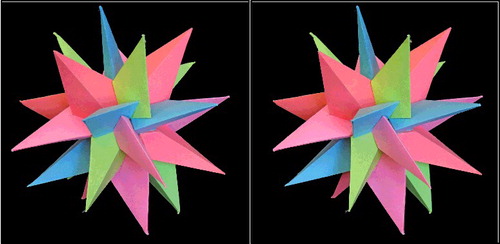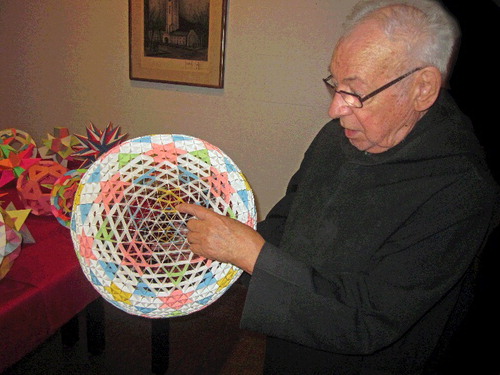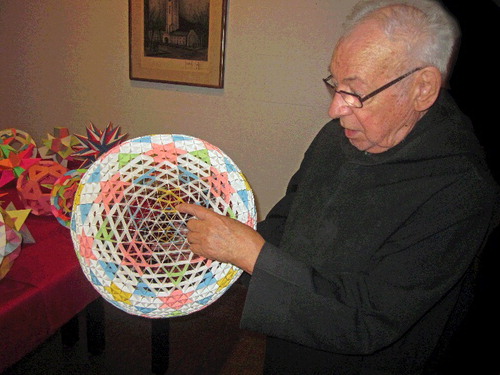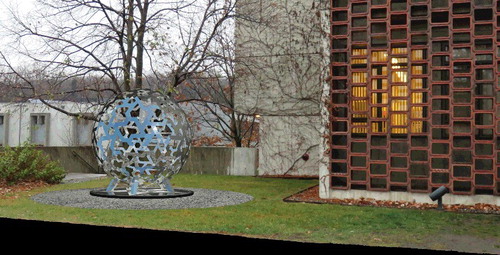Joseph Wenninger, born 31 October 1919 in Park Falls, Wisconsin was the second of seven sons of German immigrants. It was understood that his brother Heinie would become a baker like his father and, he, being the second son, would go into the priesthood. After attending Saint John's Abbey and professing Benedictine monastic vows, 11 July 1940, he took the name of Father Magnus J. Wenninger. He was ordained a Roman Catholic priest on 2 September 1945.
There were many times I heard Father Magnus tell the story about his decision to become a teacher of mathematics. In late 1945, after being ordained a priest, his Abbot told him the Order was starting a school in the Bahamas, and assigned him to go there and teach. ‘What will I teach?’ he asked. The reply he got was, ‘They will tell you when you get there.’ In preparation for his departure, he enrolled at the University of Ottawa and earned a Master's degree in philosophy. After arriving in the Bahamas, he was given the choice to teach philosophy or mathematics. He chose mathematics. Father Magnus often said after deciding to become a Benedictine monk the choice to teach mathematics turned out to be the most significant decision in his life. At St Augustine's College, Nassau, the Bahamas, he began his lifelong adventure in education and taught mathematics. Father Magnus spent four summers earning another Master's degree. This time, it was in Mathematics Education at Columbia University Teachers College, New York, NY, USA. While he was there, he became enthralled by Col. Robert S. Beard series of polyhedron models. This began his hermetic pilgrimage through study of polyhedrons and polytopes. He has made several hundreds of polyhedron models () and written several articles and books on the topic, including Polyhedron Models for the Classroom [Citation1], which has become a staple in different languages in classrooms around the world.
Following his last book, Father Magnus continued constructing models throughout the rest of his life. In addition to understand the physical world, the model making was also a contemplative, meditative activity for Wenninger. He has explained that, while making a polyhedron model, he would contemplate the meaning of the passage just read.
Father Magnus J. Wenninger along with H.S.M. Coxeter, Arthur L. Loeb, Thomas F. Bancchoff, Marjorie Senechal and others made major contributions to rekindle the interest in geometry as an integral part of mathematics education. The fundamental connection that polyhedron, at all levels of complexity, have to the natural world is expressed in his work. Therefore, through his polyhedron modelling, he demonstrated the importance of model making as an aid to solving complex problems across disciplines. His books, articles and his actively building polyhedron models at many conferences and classrooms inspired all ages across many educational disciplines. On a personal note, Dennis Dreher, the artist stated in a letter addressed to Father Magnus:
I am one of the lucky ones who attended your presentation at the Philomorphs (hosted by Arthur L. Lobe at Harvard University) in March of 1975. You have had a lasting influence on my work ever since, both your wonderful color work, and the extraordinary mathematical and physical precision you use to craft your work.
This is an example of letters Father Magnus received throughout his lifetime and illustrates the wide influence he had on many individuals in many areas of interest. In my own work in studying the unique families of polycylinderhedron, his philosophical approach and understanding of the value of geometry and modelling were major influences. His approach to problem solving has assisted me in making connections and discovering relationships across disciplines.
In his retirement years, Father Magnus began to enter the digital age. He began using the computer program, Stella4D, to investigate new stellated forms of polyhedron. He was an advocate for using digital visualization techniques to assist in understanding complex forms of polyhedron. Inspired by his advocacy for using modern visual techniques, I have included here one such technique: a stereographic photograph of one of his Stella4D Models (). When I gave him several stereo photos of his models, he was delighted with the way they show the complexity of the models. It is useful when studying three-dimensional (3D) complex objects in physics, chemistry, biology or in art. It has also become popular among young people due to the introduction of low cost IPhone headsets for 3D graphic displays.
Figure 2. 3D cross-eye stereo image of a Magnus J. Wenninger Stella4D Model. To view the stereograph using the cross-eye technique, focus on your finger at about six inches forward of your eyes. Maintain focus. Insert the page beyond your finger about eight inches. Try to stare blankly, without actually ‘looking’ at anything. Move the page slowly forward and backward. When you reach the proper position, your eyes will focus and the image will come into full 3D view.

In 2008, Magnus was awarded the Lifetime Achievement Award from the Special Interest Group on Mathematics and the Arts of the Mathematical Association of America. He died peacefully on 17 February 2017.
One polyhedron that he has made is called ‘Order-in-Chaos.’ It was Father Wenninger's favourite. In honour of his contributions to humanity, Saint John's wishes to build a large sculpture of it to be located in front of the St John's Peter Engle Science Building ().
Reference
- M.J. Wenninger, Polyhedron Models for the Classroom, National Council of Teachers of Mathematics, Reston, Virginia 1966.



